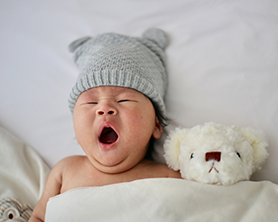Many first-time parents ask themselves how they will ever change a nappy with as little mess, fuss and “incidents” as possible. Here’s how to make nappy changing a little less daunting.
Preparing to change a nappy
Set up a nappy-changing area at home with clean nappies, wipes, cotton wool and a barrier cream. It’s also handy to have waterless cleanser to clean hands easily. Don’t rely on the nappy’s smell as a cue to change – your baby could be filling up to 10 nappies a day. Always change the nappy when it’s wet; this way your baby will always stay dry and you’ll prevent chafing and nappy rash.
How to change nappies
- Lay your baby on their back on a firm flat surface. Remove any clothing that inhibits access to the nappy. Never leave your baby unattended – the smallest movement could cause them to fall.
- For disposable nappies, pull up the sticky tabs. For reusable cloth nappies, remove the cover and snaps or Velcro from around your baby's waist.
- With your fingers around their ankles, lift your baby up gently so you can remove the nappy out from under their bottom. If there's poop in the nappy, use the front half of the diaper to wipe it off your baby's bottom, front to back. Fold the dirty nappy in half under your baby, clean side up, which provides a layer of protection between the clean nappy and your baby's bottom.
- If you have a boy, you might want to cover his penis with a clean cloth or another diaper so he doesn't pee on you.
- Clean your baby's front and bottom with a wet wipe or clean cloth. If your baby's a girl, wipe from front to back. This helps keep bacteria from causing an infection.
- Take a fresh nappy and place it under your baby. Bring the front part up on your baby's stomach and fasten the tabs to secure the nappy at their waist. For a boy, be sure to point the penis down so he's less likely to pee over the top of the nappy. The nappy should be snug but not so tight that it pinches, and make sure the tabs aren't sticking to your baby's skin.
- Replace any clothing over the new nappy.
- Fold up the dirty nappy and place it in a dustbin or nappy pail depending, and wash your hands.
If your baby won’t lie still and likes moving around while being changed, try to play games like “peekaboo”, distract them with a mobile, or sing songs. You could even move the changing station to a spot that offers a view – for example overlooking the garden.
How do I spot nappy rash?
If your baby’s nappy area looks irritated and red, chances are it's nappy rash.
To treat it, gently cleanse the nappy area and pat dry. Smear on a thick layer of nappy rash cream or ointment containing zinc oxide or petroleum, such as Purity & Elizabeth Anne’s Petroleum Jelly, which helps to soothe skin and create a protective barrier from moisture.
If the rash doesn’t disappear after a few days, contact your doctor.
References:
- http://www.parenting.com/article/diapering-boys-vs-diapers-girls
- http://www.babycenter.com/0_how-to-change-a-disposable-diaper_3838.bc
- http://www.mydeliciousambiguity.com/2010/08/tips-for-changing-busy-baby-or-toddlers.html
- http://www.parents.com/baby/diapers/diaper-change/how-to-diaper-change/
- http://www.babycenter.com/0_diaper-rash_81.bc http://kidshealth.org/en/parents/diaper-rash.html#
Related Products:





